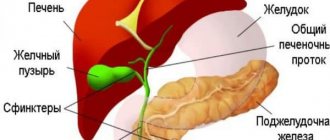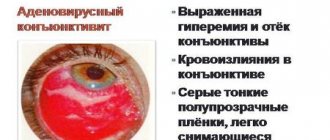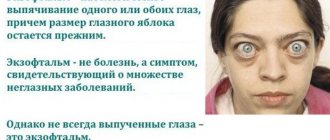If you have been diagnosed with a spasm of accommodation, what kind of disorder it is and what the mechanism of this disease is, you need to know. These are functional disorders associated with improper functioning of the ciliary muscle, which continuously contracts. Such contractions, in turn, cause both eyes to automatically focus on near objects.
This phenomenon causes unpleasant symptoms, including:
- decreased visual acuity;
- rapid eye fatigue;
- painful sensations in the eyes, frontal area and temples.
Spasm of accommodation in adults is an unpleasant and dangerous phenomenon, which, if ignored for a long time, can lead to severe deterioration of vision and myopia. False myopia is diagnosed by an ophthalmologist after a thorough examination. A comprehensive treatment prescribed by a doctor will help cope with the disease and improve a person’s well-being. However, before we begin to consider possible treatment options, it is necessary to find out what a spasm of accommodation is and what is the mechanism of this defect.
Spasm of accommodation: mechanism
Before considering the possible causes of a problem such as spasm, it is necessary to find out what accommodation is.
Accommodation is a mechanism that allows the eyeballs to focus at different distances.
Like all processes in the body, this one is regulated by the coordinated work of several elements of the human body. The main work when focusing vision is performed by the accommodative apparatus, which consists of 3 main elements of the main apple: the lens, the ciliary muscle and the ligaments of cinnamon.
The ciliary muscle consists of smooth muscle fibers, which are relaxed during distance accommodation. When focusing your gaze on nearby objects and objects, the muscle fibers tense, and the ligaments of Zinn stop their contraction. During these processes, the curvature of the lens increases, which increases the refraction of the eyeball.
If this process is accompanied by a spasm of accommodation, the ciliary muscle does not relax fully and is in a state of prolonged, disordered contraction. This, in turn, leads to overstrain of muscle fibers, disruption of their blood supply and the risk of developing chorioretinal dystrophy.
Habitual eye strain
The act of seeing
The act of vision is a rather complex mechanism. To get a clear and correct image, the object being viewed must travel a very long and difficult path. Visual rays pass through the refractive media of the eye, enter the retina, then along the optic nerve into the cortical part of the visual analyzer. And only then does the brain give a signal of clear and clear vision. If at least one obstacle is encountered on this path, then there will be no high vision. The cornea is the first to encounter the object. It has a constant refractive power. If the cornea has no damage or pathological phenomena, then the visual rays, passing the lens, are focused on the retina. To get a clear image, the rays must converge at a single point. For this, it is not enough to have complete transparency and correct shape of the cornea and lens.
The clarity and clarity of vision also depends on accommodation - the ability of the eye to view objects at different distances, that is, the perception of rays of different directions. The closer the object in question, the more rays will try to focus at the point of clear vision on the retina. In the eye itself, the function of accommodation is performed by the ciliary body, the ligament of Zinn and the lens. The stimulus to trigger the accommodation mechanism is the receipt of an unclear image on the retina due to lack of focusing.
Accommodation mechanism
The mechanism of accommodation was identified and described by Helmholtz. It begins with contraction of the circular muscles of the ciliary muscle fibers. These muscles are the outer layer of the muscle rings of the ciliary body. From the ciliary body, its flat part, which is located at the root of the iris, comes the delicate ligament of Zinn, which is woven into the lens. Contraction of the fibers of the orbicularis muscle leads to a weakening of the tension of the ligament, which is responsible for changes in the curvature of the lens. The lens, being an elastic formation, increases its curvature and refractive power. But the mechanism of accommodation consists not only in the contraction of the ciliary muscles, but also in their relaxation.
For distance vision, the orbicularis muscles must be relaxed, and for near vision, their tension must be stimulated. The closer the object, the stronger and more active the muscle contraction occurs. Accordingly, a long stay at work at a close distance very easily leads to accommodation tension, or spasm.
In addition to the internal mechanism of accommodation, there is also a central apparatus. In the occipital part of the brain there is its reflex center, in the motor zone of the cortex - the motor center and in the anterior colliculus - the subcortical or visual. The motor and subcortical centers are connected to the oculomotor nerves. In the optic tubercles, transmission occurs from the optic nerve to the oculomotor nerve. In turn, the oculomotor nerve triggers the accommodation mechanism in the eye itself. It turns out that in order for the accommodative apparatus to work without failures, its normal regulation is also necessary from the brain. This is possible with sufficient and correct blood supply.
Causes
False myopia, as statistics show, develops much more often in children and adolescents. This is due to age characteristics. Let's consider the main negative factors and reasons that can lead to a diagnosis of accommodation spasm.
A spasm of accommodation in schoolchildren and adolescents can be caused by:
- long periods of watching television;
- unlimited time spent at the computer;
- uncomfortable and incorrectly selected study furniture;
- frequent reading in poor lighting and at close range;
- prolonged exposure of the eyes to too much bright light;
- improper daily routine for schoolchildren: regular lack of sleep, lack of walks in the fresh air, poor nutrition;
- asthenia;
- hypovitaminosis;
- curvature of the spine (scoliosis);
- osteochondrosis.
In older adults, false myopia is quite rare.
This is due to the thickening of the lens (at the age of 40–45 years) and a decrease in its elasticity.
The age-related weakening of accommodation is called presbyopia and is symptomatically expressed in the inability to see well near. At the same time, vision deteriorates, and the person is diagnosed with farsightedness. In this case, a spasm of accommodation of the eyes can develop only with severe neuroses, attacks of hysteria, concussion, menopause, etc. In some cases, the development of such a disease in an adult can be facilitated by work associated with constant eye strain.
Spasm of accommodation: classification
Modern medicine identifies several types of this disease:
- Physiological appearance. Occurs due to prolonged visual overload. It is most common in people who, with farsightedness, regularly and often work with objects that are close. To improve their condition, glasses correction is recommended for such people. The attending physician may also prescribe special exercises and procedures to restore the functioning of the ciliary muscle.
- An artificial type of accommodation spasm is called overstrain of the ciliary muscle due to the use of eye miotic drugs. For example, Pilocarpine, Ezerina, Phosphacol. In this case, it is necessary to consult with your doctor, who will help determine the exact causes and exclude the medicine that caused such a side effect. Discontinuation of the drug relieves the unpleasant symptom.
- Pathological type of spasm. Occurs with pathological changes in the eyeball, namely with a change in hypermetropic refraction to myopic. In this case, with false myopia, the symptoms will include a progressive decrease in visual acuity.
Regardless of the type of spasm, a person should not ignore the problem and immediately seek help from an ophthalmologist.
Symptoms of the disease
In case of spasm of accommodation, treatment started in a timely manner guarantees a successful result and improved vision. However, before seeking help from a specialist, it is necessary to study the main symptoms that may indicate the occurrence of a spasm. Spasm of accommodation symptoms have the following:
- progressive farsightedness;
- double vision;
- rapid eye fatigue during work that requires concentration on nearby objects;
- pain and burning in the eyes;
- headaches in the temporal region;
- redness of the eyes, photophobia;
- general fatigue and irritability (this symptom is especially common in children).
Timely treatment of accommodation spasm is especially necessary for children. This is due to the severity of the symptoms described above for the child’s body. Sore eyes, decreased vision and chronic fatigue - all this often leads to decreased performance at school and reluctance to study.
Pathological and prolonged spasm of accommodation, in addition to ocular symptoms (nystagmus, anisocoria, eyelid tremor), can also cause general, physiological ones.
For example, patients may suffer from vegetative-vascular dystonia, emotional lability, palmar hyperhidrosis, depression, and severe migraine attacks.
Diagnosis of the disease
As already mentioned, timely treatment of accommodation spasm plays a very important role, since a person’s well-being in the future will depend on it. To do this, a person who discovers even a few of the above symptoms should immediately consult a doctor. Diagnosis of false and true myopia includes external examination and hardware techniques.
In addition, the attending physician must determine the patient's current visual acuity. This is done with the help of corrective glasses. The patient should undergo additional examination by a therapist and a neurologist. Only after undergoing all diagnostic procedures and examination by all mentioned doctors will the specialist be able to prescribe the appropriate treatment corresponding to the exact diagnosis of the patient.
How to treat spasm of accommodation? Treatment must be comprehensive. Incorrectly selected treatment (self-medication) can lead to permanent deterioration of vision and serious complications that cannot be corrected without surgical intervention.
Treatment methods
In order to accurately answer the question of how to relieve a spasm of accommodation, it is necessary to establish the causes of the disorder. Treatment must be comprehensive, so the patient is prescribed medications. We should not forget that self-medication is dangerous to health, so you should strictly adhere to the doctor’s recommendations.
If the pathology is at an early stage of development and is not advanced, then the main method of treatment is special exercises.
At first, they are performed under the supervision of a doctor, who will tell you about the correct technique for performing them. In most cases, the following exercises are helpful:
- vertical and horizontal eye movements;
- circular movements of the eyeballs;
- intense blinking (rapid contraction and opening of the eyelids);
- exercises to concentrate your gaze on the bridge of your nose;
- horizontal eye movement.
By performing such training, the patient helps the eye muscles alternate between tension and relaxation. This workout must be performed regularly, repeating each exercise 5-10 times. The number of repetitions per day should also be discussed with your doctor. This is due to the complexity of the diagnosis. The worse the condition of the eye muscles, the more gentle the training regimen should be at the beginning of treatment. Some physiotherapeutic procedures will be effective. For example, magnetic therapy and electrophoresis will be beneficial.
All of the above treatment methods will give a positive result only if the patient gives up habits harmful to the eyes, which led to the spasm. Visual hygiene will be mandatory: limited time spent at the computer, reading in the correct position and with good lighting, minimizing work that is difficult for vision.
Improving your overall quality of life will also benefit you.
The patient will begin to feel much better if he gives up bad habits, starts eating properly, plays sports and takes walks in the fresh air, and improves sleep patterns.
Symptoms of accommodation disturbance
Prolonged visual stress leads to disruption of the eye's adaptation to visual perception. Therefore, blurriness appears in viewing objects. When the image on the retina deteriorates, the accommodation voltage increases - thus, the eye tries to improve the visual image. Excessive muscle contraction increases eye strain. During near accommodation, the refractive power of the eye increases, its ability to perceive diverging rays and combine them in focus on the retina.
The closer the object under consideration, the greater the divergence of the rays of light, and the need for accommodation tension increases to its limit.
A five-minute rest will give relief for a while and improve vision, but complete relaxation will not occur, because the accommodation mechanism is already running in an enhanced mode. And the main complaint and symptom of this disease is fatigue and blurred vision. Pay attention to how often you begin to notice the blurriness of the contours of familiar objects, the dimness of pictures, how much time you can spend continuously working with video terminals.
Excessive stress, which the eyes can no longer cope with, results in irritability, headaches, a burning sensation and sand in the eyes. Some patients experience watery eyes outdoors and in the wind. Children with a strong spasm of accommodation begin to squint and move closer to the blackboard at school or to the TV screen at home. At the initial manifestations, the child will blink frequently, trying to get rid of the feeling of a veil before his eyes, and rub his eyes.
Pupils of 1st - 2nd grades become capricious and inattentive due to blurred vision, because the general assimilation of the subject is disrupted. Parents should pay attention to these symptoms, because in the early stages of accommodation disturbances, further deterioration of vision can be prevented. Preventive examinations have now become relevant in kindergartens and schools. But in most cases, children and adults, having heard from the doctor that this is a spasm of accommodation, do not treat this problem as something serious.
However, pseudomyopia, as this disease is otherwise called, can very easily and quickly turn into true myopia.
Considering that muscle function also depends on central regulatory mechanisms, one examination by an ophthalmologist will not be enough. Most likely, you may need to consult a neurologist or ENT doctor. Disturbances in the functioning of the ciliary muscles can be affected by head injuries, birth injuries, increased nervous excitability in children, stressful conditions, previous respiratory and infectious diseases that occur with high body temperature.
Office workers and parents of children who have a history of something similar should pay attention to these reasons. Undoubtedly, the diagnosis of “spasm of accommodation” can only be made by an ophthalmologist, but this problem can only be dealt with together with the patient.
Preventive measures
If a person is diagnosed with spasm of accommodation, a specialist is consulted about appropriate treatment. However, absolutely every person is able to protect themselves from unpleasant symptoms and problems associated with them. For this purpose, there are preventive measures, the observance of which will help keep the eye muscles toned and in good condition. Prevention of eye muscle spasm includes:
- avoiding eye strain;
- regular breaks when working at the computer;
- frequent walks in the fresh air;
- lack of too bright lighting in the evening;
- proper nutrition, including vitamins and nutrients;
- reading in conditions favorable to the eyes - at a sufficient distance and in the right lighting;
- good work, in which the eye muscles do not experience constant tension.
Even if all the described preventive measures are followed and there are no unpleasant symptoms, a person is recommended to regularly visit an ophthalmologist.
Prevention
General strengthening of the body and stimulation of the immune system, sports and fitness, sets of special visual exercises, and a nutritious diet are indicated.
All rules and regulations regarding computer work and reading, lighting rules, seating and workplace equipment must be strictly observed. If you have additional vision problems, it is important to be sure to choose the right glasses.
Alena Paretskaya, pediatrician, medical columnist
1, total, today
( 39 votes, average: 4.59 out of 5)
Allergic conjunctivitis: symptoms and treatment
Allergic conjunctivitis in a child: symptoms and treatment
Related Posts
Spasm of accommodation in children
As mentioned above, children are the most common patients of ophthalmologists with a similar diagnosis. This diagnosis is especially often given to elementary school students, whose eyes could not cope with such a colossal load. Moreover, children of this age do not know how to take care of their own eye hygiene, so parents should do this. The latter often neglect the responsibilities assigned to them, so the child, after finishing school and doing his homework, sits down at the computer. This excessive strain on the eyes affects the child's vision in a negative way, causing similar problems.
If it was not possible to save the child, then treatment of spasm in childhood is practically no different from therapy in adults. Treatment is prescribed comprehensively, which includes: corrective glasses, special exercises and medications. General recommendations for lifestyle changes are also relevant for children. Healthy habits such as proper nutrition, taking vitamins, reducing time spent at the computer, getting enough sleep and walking in the fresh air - all this will greatly improve the child’s well-being. Parents also need to take control of the time devoted to homework and reading. The child must distribute the load evenly and find time to rest.
A disease such as spasm of accommodation is highly treatable.
Treatment of accommodation spasm must be timely and correct. In no case should you self-medicate, which can cause worsening. Seeing a doctor and following his recommendations will be an excellent solution to overcome all health problems. Be healthy!
Prevention of visual fatigue
Knowing how a spasm of accommodation develops, it can be prevented. Of course, most people cannot avoid working with a computer, and there is no point in quitting either. You just need to change your attitude towards your eyes. You need to start from a young age. The best assistant in this case will be an ophthalmologist. At the age of five, it is already possible to determine how adapted the eyes are to visual loads in future life.
If the family already has similar problems among relatives, then the doctor should observe such a child every 6 months, especially when the school period begins. Changes in refraction will be well revealed by an autorefractometer; examination data at different time intervals will allow you to assess how the volume of accommodation changes depending on the increase in loads. Now it would be a good idea to remind you about the dangers of gadgets for growing eyes. Don’t forget that by the age of 7, a child’s eyes adapt to the world around him, like all his organs and systems! Do not overload the visual apparatus with unnecessary excessive loads. Eye exercises won't hurt.
You don't have to wait until your vision gets worse. Eye exercises, as a preventative measure, are indicated at any age and for any vision. It’s worth reconsidering your nutritional diet. It must contain vegetables and fruits that contain beneficial substances for the eyes - carrots, apples, bell peppers, blueberries, black currants, cherries. And of course, in your work and rest regime, you must definitely include unloading time for the eyes - at least for five minutes, closing your eyes, leaning back in your chair.











